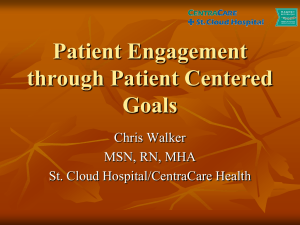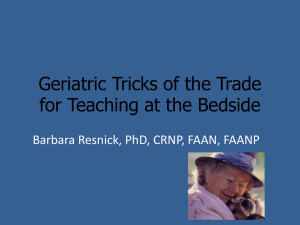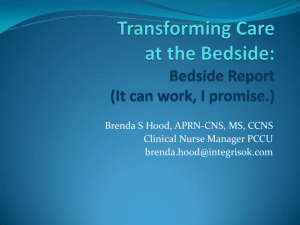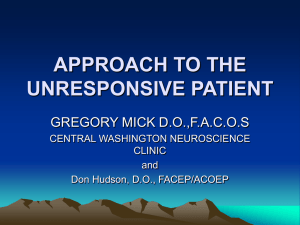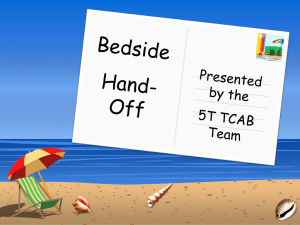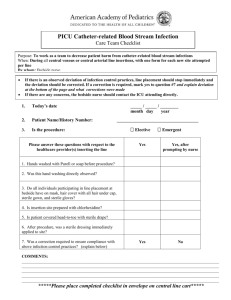Chapter-4.-Bedside
advertisement
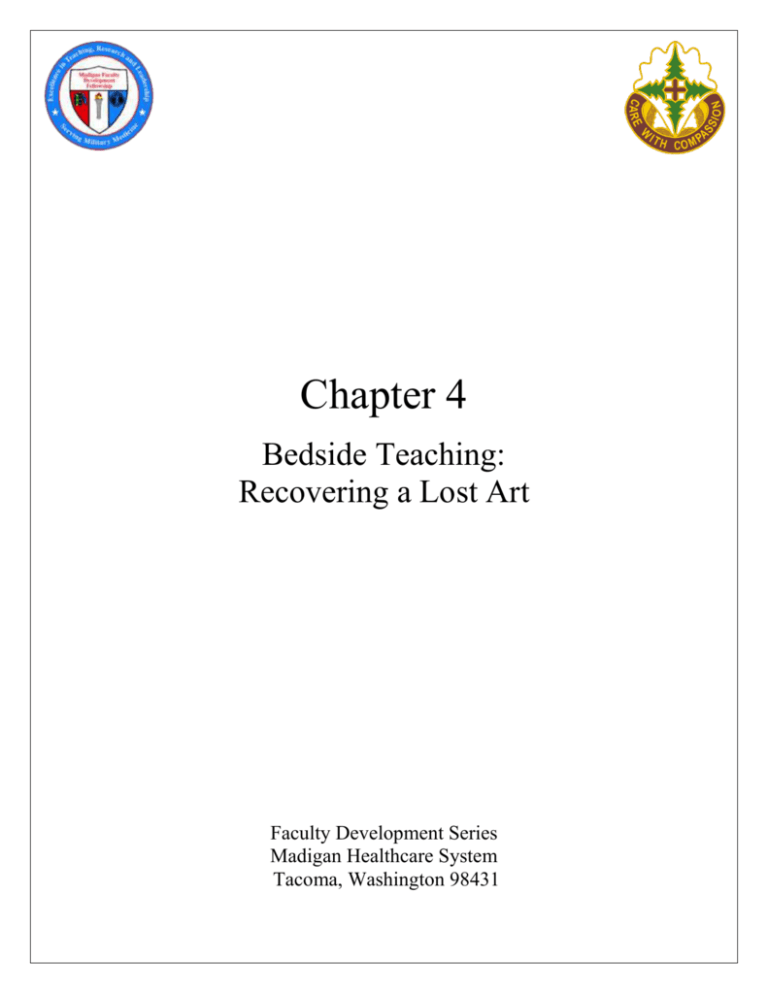
Chapter 4 Bedside Teaching: Recovering a Lost Art Faculty Development Series Madigan Healthcare System Tacoma, Washington 98431 Bedside Teaching Chapter Contents Group Leader Checklist Learner Needs and Resources Assessment (LNRA) Attendance Sheet Evaluation Form Example Eight Steps Handout Summary of Supporting References and Resources Checklist for the Group Leader Before the Session.... ___ 1. Review the suggested eight steps of planning for this presentation. ___ 2. Review the PowerPoint, handouts, and supporting references in this chapter. ___ 3. Duplicate and distribute the LNRA to faculty. ___ 4. Have faculty return the LNRA at least 5 days before the session. ___ 5. Review the faculty LNRA prior to the session. ___ 6. Modify the suggested eight steps and write your plan to fit your needs. ___ 7. Modify the PowerPoint and handout to fit your plan. ___ 8. Duplicate the appropriate number of copies of the attendance roster, faculty evaluation forms, and handouts. During the Session.... ___ 9. Have each participant sign-in using the attendance roster. ___ 10. Distribute the handout(s) to the participants. ___ 11. Conduct the session based on your eight steps of planning. After the Session.... ___ 12. Collect the evaluation forms from the faculty. ___ 13. Keep the attendance roster for the session in your department and provide the appropriate amount of CME to each participant. ___ 14. Reflect on the seminar - How did it go? What was good about it? What could have been better? Is there a better approach to this topic? Were there needs identified during this session that would be the basis for future seminar(s) in your program? ___ 15. Where will your program go from here based on this seminar? 1 Learner Needs and Resources Assessment Please complete the following needs assessment for the upcoming workshop on Bedside Teaching: Recovering a Lost Art as part of your faculty development program. The seminar will consist of an introduction by your group leader, a short PowerPoint presentation and interspersed small group activities and class discussions. The purpose of this needs assessment is to determine your learning needs and interests, so that the seminar is most useful for you. This needs assessment should also stimulate you to think about active learning before the seminar begins. We need your enthusiastic participation now, and in the seminar. It will be fun, and at the end of it, we'll be asking for your feedback! Please turn this in to your group leader (______________) no later than (_____________). 1. Have you had any formal training in bedside teaching? YES NO 2. What are some advantages to teaching at the bedside? 3. What are some barriers to bedside teaching at your hospital? 4. Think about the bedside teaching rounds made in your program. Who does them? Are they effective? What are the strength(s) of bedside rounds in your program, and which areas need improvement? Be prepared to share your thoughts with the group during the seminar. 5. List three things you would like to learn/take away from this session: a. b. c. Any other comments / concerns for this presentation: 2 ATTENDANCE ROSTER – Page____of_____Pages Department: ____________________ Institution:____________________ Title of CME Activity: Faculty Development Series – Bedside Teaching: Recovering a Lost Art Course Content: Didactic and Group Discussion – Instruction on Bedside Teaching techniques and strategies to systematically implement Bedside Teaching Instructor (Group Leader):____________________________ Date:____________ Time: Began___________ Ended________ Total ___________ Check One Name Rank Staff Physician Resident Physician Other Professional Discipline Department or Mailing Address Total Number of Learners Attending This Activity: _________ 3 Faculty Development Session Evaluation Form Date Speaker Topic Please rate the speaker using the scale below: Strongly Disagree Disagree Somewhat Agree Agree Strongly Agree Content was relevant to my needs The speaker conveyed the subject matter clearly The speaker used active learning techniques to teach this subject The speaker gave adequate time for questions Audiovisual / handout material added to the presentation Overall, the speaker was effective List one thing that you learned from this presentation: Please add your comments/suggestion for improving this session on the back—they are VERY helpful Faculty Development Session Evaluation Form Date Speaker Topic Please rate the speaker using the scale below: Strongly Disagree Disagree Somewhat Agree Agree Strongly Agree Content was relevant to my needs The speaker conveyed the subject matter clearly The speaker used active learning techniques to teach this subject The speaker gave adequate time for questions Audiovisual / handout material added to the presentation Overall, the speaker was effective List one thing that you learned from this presentation: Please add your comments/suggestion for improving this session on the back—they are VERY helpful 4 Bedside Teaching Example Eight Steps The eight steps presented below may be used as a guide for your planning. Modify these steps to meet your specific needs. Who: 8-10 faculty learners from the Department of Family Medicine Why: Enhance clinical teaching as part of a required faculty development curriculum When: 1400-1500 on a Thursday afternoon, blocked schedule for faculty development Where: Classroom, individual desks, accessible, AV supported, requires own computer What: Driven by the LNRA. How to plan and execute bedside rounds. Models to cover include: Ramani model (12 steps), Janicik model (3 domains). Identify barriers to implementation and explore strategies to overcome them. Commit to an implementation plan for the group. What For: By the end of this session, we will have: • • • • • How: Listed obstacles to bedside teaching Identified advantages of bedside teaching Tried out models for bedside teaching Found ways to overcome obstacles Planned integration of bedside teaching into inpatient rounds General: Active learning: small group activities and discussion, larger group discussion, minimal PowerPoint slides. Room contains one large table with chairs, white board, smart board connected to computer. Will group chairs to form two groups of 4-5 learners each. This will facilitate small group activities followed larger group discussions. The session will take place at 1400, so will provide coffee and cookies. Grabber: Osler quote “Medicine is learned at the bedside and not in the classroom.” Crumlish study numbers showing staff and residents value bedside teaching (may contrast with institutional experience/perceptions). Induction Tasks: 1. Began with LNRA and continued in first activities. Learners reflect on their experiences with bedside teaching. 2. Learners discuss obstacles to bedside teaching. Write list on board/easel or other prominent site in room and keep visible throughout session. Use LRNA responses to jumpstart the conversation, starting with “time” (universal barrier). 5 3. Learners discuss advantages to bedside teaching. Write and display as with obstacles above. Affirm the learners by comparing their list to data from the Crumlish study. Use LRNA responses to prepare slide. Input Tasks: 1. Introduce the Ramani and Janicik models described on the handout. Note that an excerpt from the models is also provided for the next task. 2. Have small groups review the models. Implementation Tasks: 1. Have small groups use a case from their experience to formulate a bedside teaching session using the excerpt from one model. Allow 15min for this task. Discuss what struck them about it at the end of the learning task. 2. Discuss potential solutions to obstacles they have identified. Note this may occur naturally at any point in the session. 3. Discuss any other issues identified in the LRNA not yet addressed, as time allows. Integration Tasks: 1. After reviewing and affirming the work of the learners to this point, discuss and commit (as a group) to a plan for implementation. Suggest inclusion of minimum baselines such as frequency, duration, site, and people included in bedside group. Note the need to remain flexible in day-to-day practice. Write their commitments on the board/easel/other prominent place. At the end of the session, copy this list. 2. One month after the session, e-mail the site POC for feedback on the session. Include their list of commitments from the session and request assessment of impact. So What: Learning: Learners have identified obstacles to and advantages of bedside teaching. They have reviewed two models to plan and structure bedside teaching sessions. They have identified strategies to overcome obstacles to implementation of regular bedside teaching. They have committed to a plan for regular bedside teaching. Transfer: Learners implement regular and effective bedside rounds into their inpatient care rotation. They continue to identify and seek ways to overcome obstacles. Impact: Residents and other learners improve their understanding of and performance in many dimensions of medical care. Morale and enthusiasm for inpatient care, teaching and learning all improve. 6 Bedside Teaching Handout Blending Tradition, Humanity, Art & Science Seek and Make the Most of Teachable Moments Provide Frequent and Timely Feedback to All Learners on Team Prepare, Brief, Experience, and Debrief Break Down Barriers with Flexibility, SDL, and Persistence “No books, no tapes, no audio-visual aids, no seminars, no avant-garde philosophy will ever be substitutes for the discipline of bedside medicine—the one-to-one situation where tradition, humanity, art, and science are blended." ~Unknown Bedside Teaching: The Imperative 94% of residents believe bedside teaching time is valuable 82% want more bedside teaching in the curriculum Crumlish, et al, 2009 Teachable moment: The moment when a unique, high interest situation arises that lends itself to discussion of a particular topic. Breaking Down the Barriers Barriers Limited time Attending inexperience or fear Perceived patient discomfort Overreliance on technology Learner resistance Recommendations Be selective: not every patient Don’t wait for a quorum Be flexible Faculty Development Acknowledge self as “imperfect scholar” Share the teaching Encourage self-directed learning (SDL) Ask permission 85% of patients prefer bedside rounds Enhances patient and family centered care Explain the importance of diagnostic skills Incorporate the technology at the bedside Be persistent Include all learners Never undermine the learner in front of patient 7 Take Learning to the Bedside “The best teaching is taught by the patient himself.” ~ Sir William Osler Prepare Objectives: Brief Participants: - Identify target learners - Ask patient and explain event - Determine teaching objective (e.g. interviewing, physical exam, interacting with family) - Brief learners: - Research topic as needed - Discuss expectations - Assign roles The Teaching Cycle - Clarify objectives - Review ground rules Debrief: Clinical Experience: - Ask learners for their observations - Explain - Demonstrate - Provide feedback - Learner experiences - Encourage self-directed learning - Assess Small Group Teaching: The Basics Learning Environment: Low pressure Stimulate discussion and doubt Teach from the middle Encourage self directed learning Engage the learners / Share teaching Think out loud Effective Feedback Principles (SOME TLC): Specific Timely Objective Limited Modifiable behaviors Constructive Expected (Frequent) Ask Tell / Teach Ask / Act Provide Effective Feedback: What did you do well? What questions or challenges did you have? I observed… Then give a few general teaching points. What will you do differently next time? Develop an action plan. 8 Improving Bedside Teaching Breaking Down OUR Barriers Task #1 Bedside Teaching where I work Obstacles Task #3 Solutions 1) 1) 2) 2) 3) 3) 4) 4) 5) 5) 6) 6) 7) 7) 8) 8) 9) 9) 10) 10) 9 Bedside Teaching Task #2 – Road Maps OR Focused Teaching – 15 minutes Pick ONE model below. Use a case you have seen on the ward. Work through the steps listed as if you were going from here to rounds. RAMANI MODEL: Draw a road map (steps 1-4), orient learners (steps 5-7) 1) Medical system to be covered 2) Skills or aspects to be taught 3) Observation vs. demonstration 4) Define which patients and how long 5) Objectives, expectations, ground rules 6) Assign roles (presenters, examiners, jargon police, etc.) 7) Set limits (no coverage of highly sensitive issues, etc.) JANICIK MODEL: Focused teaching (steps 1-4), Group Dynamics (steps 5-7) 1) Role model professional behavior, communication 2) Physical exam or procedural skills 3) Teach general concepts 4) Give feedback (patient can also give feedback) 5) Limit the time and goals for the session 6) Include everyone in teaching and in feedback 7) Assign roles to everyone 10 Bedside Teaching Reference model #1 The 12 Step Model B E F O R E D U R I N G (adapted from Ramani, et al, 2003) 1) Prepare goals for the session a. Use the curriculum b. Meet the learners at their level 2) Draw a road map *** a. Medical system to be covered b. Skills or aspects to be taught c. Observation vs. demonstration d. Define which patients and how long 3) Orient learners *** a. Objectives, expectations, ground rules b. Assign roles (presenters, examiners, jargon police, timekeeper, etc.) c. Set limits (no coverage of highly sensitive issues, etc.) 4) Introduction a. Introduce whole team and road map to patient b. Note primary goal is teaching 5) Interaction – Role model professional behavior for the learners 6) Observation – Step out of the limelight, support learner as primary caregiver 7) Instruction – Challenge the learners intellectually, don’t humiliate them “DO’s” Gentle corrections Keep team all engaged Admit knowledge limits Learn from your students Teach professionalism Teach hands-on skills Teach observation skills Use teachable moments “DON’Ts” One upmanship “What am I thinking?” Ask juniors after seniors Long didactics 8) Summarization – Recap for learners and the patient A F T E R 9) Feedback – From learners, what went well and/or not well 10) Debrief a. Time for questions/clarifications b. Assign further reading/research c. Discuss sensitive areas 11) Reflect 12) Prepare for next time 11 Bedside Teaching Reference Model #2 The 3 Domains Model (adapted from Janicik, et al, 2003) Attend to Patient Comfort 1) 2) 3) 4) 5) 6) 7) Ask the patient’s permission in advance Introduce everyone on the team Start with a brief overview from the primary caregiver (learner) Give explanations without using medical jargon Base the teaching points on that patient Use a genuine, encouraging closure statement Return later to check for and resolve misunderstandings Focused Teaching 1) Diagnose the patient 2) Diagnose the learner 3) Provide targeted teaching *** a. Role model professional behavior, communication b. Physical exam or procedural skills c. Teach general concepts d. Give feedback (patient can also give feedback) 4) Debrief after the session Group Dynamics *** 1) Limit the time and goals for the session 2) Include everyone in teaching and in feedback 3) Assign roles to everyone 12 Supporting References and Resources Bedside Teaching Cox, K. (1993). Planning Bedside Teaching. The Medical Journal of Australia, Vol. 158-9. University of New South Wales School of Medicine. Series of 8 articles describing a teaching cycle in detail. Source for Teaching Cycle in the handout. Full conceptual diagram: Debriefing Clinical Encounter Preparation Working knowledge Experience Explanation Cycle Cycle Briefing Preparation for next time Explication Reflection Crumlish, C. M., Yialamas, M. A., McMahon, G. T. (2009). Quantification of Bedside Teaching by an Academic Hospitalist Group. Journal of Hospital Medicine, 4:304-7. Author from Brigham and Women’s Hospital, Boston, Internal Medicine residency. Study examined time spent at the bedside during rounds (17%, deemed too low) and what residents value about bedside teaching. Most valuable parts of BT: Physical Exam Communication/Interpersonal skills Focus on pt-centered care Integrating clinical exam w/dx/mgmt decisions Ende, M. J. (1997). What if Osler Were One of Us? Inpatient Teaching Today. Journal of General Internal Medicine, 12:S41-S48. Author from University of Pennsylvania School of Medicine. He examines challenges and planning modern bedside teaching using Osler as an example of excellent practice. Principles of Learning 1) Knowledge is constructed, not accumulated 2) Expertise depends on experience with cases 3) Students learn when they are involved 4) Learning is both a personal and a social process Corresponding Rec’s for Teaching Begin with students’ conceptualization; Use probing questions; encourage reflection Focus discussions on the patient; Teach at the bedside; compare/contrast cases Provide challenge and support; stimulate interest; Make rounds fun; encourage independent learning Develop a learning community; provide orientation; Leaven credibility with authenticity; Know your learner 13 Ende, M. J. (1997). (con’t) Questions to guide planning “rounds that work” What do you hope to accomplish? What is your point of view? How will your learners be engaged? How will you meet the needs of each learner? How will rounds be organized? Are your rounds successful? How will you make the time? Gonzalo, J. D., Masters, P. A., & Simons, R. J. (2009). Attending Rounds and Bedside Case Presentations: Medical Student and Medicine Resident Experiences and Attitudes. Teach Learn Medicine, 21 (2):105-110. Authors and study from Penn State College of Medicine. 3rd year med students, Internal Medicine and Med-Peds residents surveyed about time, value and concerns over bedside rounds. Time at bedside: mean 27% of rounds (73% of rounds had <25% of time at bedside). Value: 1) Learners that had seen bedside rounds prefered bedside rounds more than those who hadn’t seen them (42% vs 13%). 2) Bedside rounds somewhat or very important for learning physical exam (89%), communication (83%), professionalism (72%), patient mgmt (59%), history-taking (55%), pain mgmt (43%). Concerns: Prevents freedom of discussion about patient’s case (75%), patient comfort (66%), concern for patient’s feelings (66%) Kroenke, K., Omori, D.M., Landry, F.J., Lucey, C.R. (1997). Bedside Teaching. Southern Medical Journal, 90 (11):1069-74. Primary author from USUHS, Dept of Medicine. Review of five common obstacles to bedside teaching and potential solutions for each: Obstacle Time constraint Potential Solutions Pre-designate time during rounds (30min/day, 1 pt/day, etc); Be selective in target for each encounter Selecting targets Attending picks based on presentation (confusing hx, abnormal exam); Attending asks team to pick; Someone notes a great learning point independently Demonstrate vs. observe Demonstrate advanced skills; Observing residents slower but better learning Staff insecurity "No finding is too mundane"; Chronic findings still valuable; Learn together as a team; Role model compassion/professionalism Learner dislikes Boredom Fear of embarrassment Plan ahead, limit single-resident exam time Set the tone before bedside rounds; Teach vice putting on the spot; Specify goals/agenda 14 Janicik R. W., Fletcher, K. E. (2003). Teaching at the bedside: a new model. Medical Teacher, 25 (2):127-130. Source for model cited in handout. Lehmann, M. L., Brancati, M. M., Chen, M. M.-C., Roter, D. D., & Dobs, M. M. (1997). The Effect of Bedside Case Presentations on Patients’ Perception of Their Medical Care. The New England Journal of Medicine, 336:1150-1156. Authors and study from Johns Hopkins Hospital, Internal Medicine inpatient service. RCT design. Patients with bedside presentations reported doctors spent more time with them, reported slightly better quality of care. Lower education level associated with more complaints of doctors using jargon. Mooradian, N.L., Caruso, J.W., Kane, G.C. (2001). Increasing Time Faculty Spend at the Bedside During Teaching Rounds. Academic Medicine, 76 (2):200. Essay from authors at Jefferson Medical College. Residents evaluated attendings by time on ward, gave feedback to PD (no names), increased incidence of teaching at the bedside from 30% to 70%. Points for successful rounds: Obtain pt consent prior to rounds Ask residents/students to demonstrate PE findings Explain to pt purpose of rounds Model professionalism Introduce team Allow pt to stop session Be courteous Allow pt the last word/question Ramani, S., Orlander, J. D., Strunin, L., & Barber, T. W. (2003). Whither Bedside Teaching? A Focus Group Study of Clinical Teachers. Academic Medicine, 78 (4):384-390. Author is from Boston University. Focus groups among faculty describe obstacles/solutions. Specific Barriers Teacher Declining BT skill Inexperience Performance pressure Lack of control Tough to engage whole team Not believing BT worthwhile Belief BT is for residents to do System Interruptions Short admissions Technology overload Patient Patient discomfort w/idea of BT Patient too ill (unstable) Patient off ward Patient misunderstanding lingo Patient privacy Uncooperative/angry patient Climate Limited time Lack of faculty training Lack of faculty rewards Lack of role models Miscellaneous Crowded room No blackboard/X-ray view-box Can't refer to textbook Teacher/learner hesitancy in discussing Differential Dx Fear of undermining house staff Learner fatigue 15 Ramani, S., et al (2003). (con’t) Strategies to Increase/Improve BT Pre-rounds Prepare goals for each session Orient learners to those goals (PE, communication, professionalism) Orient patients to purpose of rounds During rounds Establish safe environment ("I don't know" is OK) Respect learners (1° caregiver, challenge don't humiliate) Respect patients (humans, not specimens) Engage everyone in the room Involve the patient Match teacher-learner goals Post-rounds Debrief Ramani, S. (2003). Twelve Tips to Improve Bedside Teaching. Medical Teacher, 25 (2):112115. Source for model cited in handout. Williams, K. N., Ramani, S., Fraser, B., & Orlander, J. D. (2008). Improving Bedside Teaching: Findings from a Focus Group Study of Learners. Academic Medicine, 83 (3):257264. Authors from Boston University. Focus groups among residents describe obstacles/solutions. Personal Barrier Low initiative Low teacher/learner expectations Low BT teaching skills Strategy Institutional incentives Set explicit expectations/objectives Set good learning environment Acknowledge learners needs Plan flexibility per workload Selectively/efficiently integrate BT w/work Set teaching time limits Faculty development Reassure: EVERYONE has something to offer Low clinical knowledge/skills Interpersonal Pt uncooperative Ask beforehand Orient pt to format/goals Include/inform pt Respect learner-pt relationship Negotiate level of autonomy Supportive learning environment Share teaching w/team members As above (interpersonal category) Lack of learner autonomy Learner/pt fear of embarrassment Environmental No time (workload/turnover rate) Competing faculty duties Low expectation/incentive to teach Low recognition Focus on technology vice clin skill Interruptions, excessive noise Lack of privacy/space in room 16 Team cap, add nonteaching service Reduce them Set explicit expectation/objectives Create incentives Create rewards Faculty development, EBM on clinical skill (no strategy offered) (no strategy offered) Wright, M. S., Kern, M. M., Kolodner, S. K., Howard, D. D., & Brancati, M. M. (1998). Attributes of Excellent Attending Physician Role Models. The New England Journal of Medicine, 339:1986-1993. Authors from Johns Hopkins University, study examined four teaching hospitals. Residents identified excellent role models, those role models and other “control” teaching staff were queried via questionnaire regarding various attributes. Those attributes associated with being identified as an excellent role model included: 1. >25% of time spent teaching 2. >25hrs/week teaching or rounding while on an inpatient service 3. Stressing importance of the doctor-patient relationship in one’s teaching 4. Teaching psychosocial aspects of medicine 5. Having served as a chief resident 17

